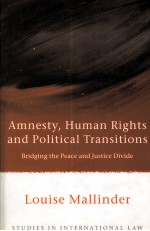图书介绍
AMNESTY,HUMAN RIGHTS AND POLITICAL TRANSITIONS BRIDGING THE PEACE AND JUSTICE DIVIDE【2025|PDF下载-Epub版本|mobi电子书|kindle百度云盘下载】

- LOUISE MALLINDER 著
- 出版社: OXFORD AND PORTLAND,OREGON
- ISBN:1841137715
- 出版时间:2008
- 标注页数:586页
- 文件大小:41MB
- 文件页数:627页
- 主题词:
PDF下载
下载说明
AMNESTY,HUMAN RIGHTS AND POLITICAL TRANSITIONS BRIDGING THE PEACE AND JUSTICE DIVIDEPDF格式电子书版下载
下载的文件为RAR压缩包。需要使用解压软件进行解压得到PDF格式图书。建议使用BT下载工具Free Download Manager进行下载,简称FDM(免费,没有广告,支持多平台)。本站资源全部打包为BT种子。所以需要使用专业的BT下载软件进行下载。如BitComet qBittorrent uTorrent等BT下载工具。迅雷目前由于本站不是热门资源。不推荐使用!后期资源热门了。安装了迅雷也可以迅雷进行下载!
(文件页数 要大于 标注页数,上中下等多册电子书除外)
注意:本站所有压缩包均有解压码: 点击下载压缩包解压工具
图书目录
Introduction1
Defining ’Amnesty’3
Controversial Nature of Amnesty Laws7
Amnesties, International Law and Legal Claims-making7
Amnesties and the Views of Victims10
Amnesties and Pragmatic Peacemaking12
Amnesties and Dealing with the Past13
Amnesty and Reconciliation16
Trends in the Introduction of Amnesty Laws18
Creating the Amnesty Law Database22
Structure and Purpose of the Book24
Part I Amnesties and Peacemaking: Context and Content27
1Enacting Amnesties29
Introduction29
How are Amnesty Laws Introduced?30
Exercises of Executive Discretion31
Negotiated Peace Agreements32
Statutes33
Public Consultation34
Why Do States Introduce Amnesty?37
Amnesty as a Reaction to Internal Unrest and Domestic Pressure41
Amnesty as a Tool for Peace and Reconciliation46
Amnesty as a Response to International Pressure61
Amnesty as a Cultural or Religious Tradition63
Amnesty as Reparation64
Amnesty as a Shield for State Agents66
Repeated and ’Rolling’ Amnesties68
Conclusion71
2 Whom do Amnesties Protect? The Personal Jurisdiction of Amnesty Laws75
Introduction75
Amnesties, Equality and the’Myth of Equivalency’76
How have States Distinguished between Offenders with Different Allegiances?82
State Agents85
Opponents of the State87
Non-Violent Political Prisoners88
Exiles and Refugees89
Foreign Nationals91
Can an Offender’s Reasons for Committing a Crime Justify an Amnesty?92
Ideology and Political Offenders93
Duress96
Self Protection and Personal Gain97
Victim-Perpetrator Axis98
Importance of Rank: Should States distinguish different Levels of Responsibility100
Amnesty for Subordinates?100
Amnesty for Superiors?102
Individual u Blanket Amnesties110
Can Amnesties Prevent Individuals from Proving their Innocence?111
Conclusion113
3 Granting Immunity? The Material Scope of Amnesty Laws117
Introduction117
Which Crimes Are Granted Amnesty?118
Amnestying Atrocities? Can States Amnesty Crimes under International Law?123
Should Amnesties Treat Political Crimes Differently?135
Impinging on Individual Rights: Amnesties for Crimes Against Civilians and Combatants who are Hors de Combat144
Do States Amnesty Economic Crimes?145
Restricting Amnesties and the Scope of the Duty to Prosecute148
Conclusion150
4 Towards Greater Accountability: The Role of Conditional Amnesties153
Introduction153
Which Conditions are Attached to Amnesties?154
Amnesty for Surrender and Disarmament156
Application Deadlines for Amnesties159
Amnesty and Repentance160
Amnesty and the Search for Truth163
Amnesty and Repairing the Harm171
Amnesty and Restorative Approaches to Justice184
Lustration and Vetting Procedures and Amnesty189
Enforcing Conditions and the Potential of Temporary Amnesties192
Conclusion197
Part Ⅱ Approach of Courts to Amnesties201
5 Implementing the Amnesty: The Approach of National Courts203
Introduction203
Trends in the Responses of National Courts to Amnesty Laws204
How have National Courts explained their Approach to Amnesty Laws?209
Legality of Amnesty Processes Under Municipal Law210
Legality of Amnesty Processes Under International Law218
Adhering to the Separation of Powers Doctrine232
Learning from Experiences Elsewhere236
Promoting Peace and Reconciliation239
Disclosing or Concealing the Truth241
Conclusion244
6 International Courts and National Amnesty Laws247
Introduction247
Whom do International Courts Hold Accountable?248
Who has Standing?252
When do International Courts have Jurisdiction to Rule on National Amnesties?253
Potential to Create Change: How the Rulings of International Courts Can Affect National Amnesties?261
Amnesties and Victims’ Rights: The Verdicts of the International Courts262
Right to a Remedy263
Duty to Investigate266
Duty to Prosecute and Punish270
Right to Reparations277
Potential Approach of the International Criminal Court279
Security Council Deferral (Article 16)282
Complementarity (Article 17)282
Non bis in idem (Article 20)285
Prosecutorial Discretion (Article 53)286
Conclusion291
7 Beyond Territoriality: Transnational Prosecutions and Amnesties293
Introduction293
Jurisdiction of Courts in Third States to Rule on Amnesties Introduced Elsewhere294
Treaty Law295
Customary International Law299
Domestic Law302
Scope of Universal Jurisdiction within Third States304
Role of Subsidiarity304
Executive Discretion308
Nexus Requirement’ and In Absentia Prosecutions309
Selectivity311
Ripple Effect’: The Impact of Investigations in Third States on National Amnesties311
Conclusion314
Part Ⅲ Views of Stakeholder Groups317
8 Legal Obligations u Self-interest: The Contradictory Approach of International Actors to Amnesty319
Introduction319
What Motivates International Actors’ Decisions on Involvement in Domestic Amnesty Processes?321
Attitudes of International Actors towards Amnesties327
Diplomatic Pressure331
Economic Pressure340
Legal Pressure342
Military Pressure350
Conclusion351
9 Prioritising Needs: Amnesties and the Views of Victims355
Introduction355
Research on Victims356
Identifying Victims and their Needs358
How do Amnesty Laws Affect Victims?365
热门推荐
- 2289599.html
- 88487.html
- 3458195.html
- 3676477.html
- 1633659.html
- 746376.html
- 1999951.html
- 2672709.html
- 1682351.html
- 375652.html
- http://www.ickdjs.cc/book_2380638.html
- http://www.ickdjs.cc/book_598020.html
- http://www.ickdjs.cc/book_1700065.html
- http://www.ickdjs.cc/book_1283087.html
- http://www.ickdjs.cc/book_3239266.html
- http://www.ickdjs.cc/book_309355.html
- http://www.ickdjs.cc/book_168725.html
- http://www.ickdjs.cc/book_624175.html
- http://www.ickdjs.cc/book_2524152.html
- http://www.ickdjs.cc/book_3396304.html